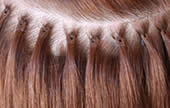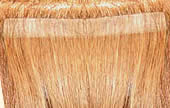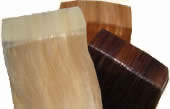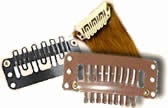Hair Extensions
 What is the best hair extension method for me?
What is the best hair extension method for me?
The answer to this question depends on several factors. It depends on your hair, your scalp, your lifestyle, the result you would like to accomplish and of course also your budget.
The available systems can be different in the way the hair extensions are prepared, in the technique used to attach it to your own hair, and in what kind of hair is used. Some systems only differ from the materials that are used or just from name. For example micro-cilinder and micro-beads are two very similar hair extension techniques.
Below we will discuss the different methods that are used for both glue based and non-glue based techniques.
How much do hair extensions cost?
The price for hair extensions depends on several factors. In most cases the biggest factor is the cost of hair. The quality, the length and the amount of hair needed to obtain the desired result play an important part in the price. The most expensive hair is very carefully collected and not chemically treated human hair with all cuticles in the same direction, often called Remy hair. The cheapest human hair available is usually processed Asian hair that is stripped from it's cuticles. For cheaper hair extensions synthetic hair is also an option. (Read more about the different types and qualities of hair used for synthetic and human hair extensions)
Another important part of the price is the technique used for attachment. The more time consuming the process is the more it will cost. Attaching a weft or tape-ins will take much less time than adding hair extensions strand by strand and therefor will be less expensive.
In addition different salon can charge different prices for the same technique. Well trained certified and experienced stylists will usually cost more than a stylist who is not certified and has little experience in doing hair extensions.
Prices can vary from a few hundred to a few thousand dollars.
In general you get what you pay for.
Do your homework before getting hair extensions
Every method can damage your own hair if it is not done properly. When attachment and removal is done by an experienced certified extensionist you will reduce the risk of damage to a minimum.
The popularity of hair extensions made that many stylists and businesses jumped on developing their own methods and brands. New techniques are still developed. All the different methods that are available now can be very confusing. What works well for someone else is not necessarily the best solution for you. That is why it is important to investigate all available methods and to visit several stylists and salons for a consultation.
The different methods will be discussed below.
How many hair extensions do I need?
The amount of hair needed depends on the result you like to obtain. Always consider the texture and thickness of your own natural hair. In general it takes less hair to add more volume than to add more length. From short to long hair will take more hair than from half-long to long to keep it natural looking.
For a strand by strand method you'll roughly need 100 to 150 strands for volume and length and about 75 for just adding volume. If you have short hair and want to add length it can go up to about 200 strands.
Wefts are wider than strand by strand methods and are usually measured in grams. In general 75 to 250 grams are needed.
These are average numbers. It depends on several factors how much hair is needed. Talk to your stylist. After looking at your hair type your stylist must be able to tell you how much hair you need to obtain the result you desire.
How long will my hair extensions last?
Some systems last longer then others but in general we can say that hair extensions last anywhere between 2 and 6 months. This is sometimes because the attachment breaks but mostly because extensions connected to your hair will get more loose as your own hair grows (approximately 0.4" per month). Depending on how fast your hair grows and how well you take care of your extensions they have to be removed or retightened when they get too loose.
With some techniques it is possible to reuse the hair what can save you some money, this also depends on the hair quality and how well you take care of it.
How are extensions attached to my own hair?
There are many different ways but we can divide them in 2 major groups:

Glue/Bond based attachment
With many techniques some kind of glue or bond is used for attachment. Some bonds can be harmful for your hair or skin, others are perfectly safe. With some bonds special solvents are used for removal. Always ask your stylist what type of bond will be used if you select this method.
With some methods the bond is applied to the extension hair when it is attached to your hair with other methods the extensions are pre-tipped (often named "U-Tips"). Many methods use keratin bonds. Keratin is a fibrous protein forming the main structural component of hair.
The "fusion" between hair is in most cases done with a special tool. There are hot fusion and cold fusion methods.
Tape is another method that is used. Tape extensions are usually in the form of a small weft that comes with the tape pre-attached.
In general it is best not to brush or wash your hair for 48 hours until the bonds a fully secure.
NON Glue/Bond based attachments
Different types of beads, micro links or cylinders, Shrink-links, clips, threads and braids etc. are used for attachment. Some methods come with a "link" pre-attached (often called I-Tips). With most linking methods the hair is pulled through the cylinder which is tightened what will secure the hair. There are different types of beads. They can be made of a different material (mostly aluminum) and some are coated on the inside. Beads come in different sizes and colors.
Nano extensions use the smallest micro ring available at this moment. The nano ring is usually made of aluminum and lined with silicon.
Thread techniques can be very time consuming. The extension is tightened to the hair with thin thread in a small knot.
All different techniques are described separately.
Hair Extension Methods
The many different brands are featured separately. They can be placed in 3 categories:-
Strand by strand techniques
 With this technique small strands of extension hair are attached one by one to small sections of your own hair. It can take several hours to apply all strands. Depending on the desired result on average 50 to 100 strands are needed. When done properly the it will blend in naturally with your own hair. It can be done using Glue based or NON Glue based attachments. When your hair is very thin and fragile and breaks easy this is probably not the best method for you.
With this technique small strands of extension hair are attached one by one to small sections of your own hair. It can take several hours to apply all strands. Depending on the desired result on average 50 to 100 strands are needed. When done properly the it will blend in naturally with your own hair. It can be done using Glue based or NON Glue based attachments. When your hair is very thin and fragile and breaks easy this is probably not the best method for you.
Weft hair extensions
 A weft is a track of several inches long on which the hair is already attached (a curtain of hair attached together at the top and free flowing at the bottom). A weft can be made by a machine or by hand. Handmade wefts are better, they are custom made to suit your head and match your hair. The extensions are then applied by using one row (track) at the time instead of strand by strand. This can also be done with Glue based or NON Glue based attachments. Compare the different weft hair extension brands.
A weft is a track of several inches long on which the hair is already attached (a curtain of hair attached together at the top and free flowing at the bottom). A weft can be made by a machine or by hand. Handmade wefts are better, they are custom made to suit your head and match your hair. The extensions are then applied by using one row (track) at the time instead of strand by strand. This can also be done with Glue based or NON Glue based attachments. Compare the different weft hair extension brands.Tape-in hair extensions
 Tape-in extensions are small wefts with adhesive tape on one side. It is also called "sticker hair" by some companies. The application can be done without the use of any tools. In general your own hair is "sandwiched" between two strips of tape with the adhesive tape glued together. For finer hair you can use a single sided tape application. With this application a tape extension and a single sided adhesive tape are glued together with your own hair in between. Compare the different Tape In hair extension brands.
Tape-in extensions are small wefts with adhesive tape on one side. It is also called "sticker hair" by some companies. The application can be done without the use of any tools. In general your own hair is "sandwiched" between two strips of tape with the adhesive tape glued together. For finer hair you can use a single sided tape application. With this application a tape extension and a single sided adhesive tape are glued together with your own hair in between. Compare the different Tape In hair extension brands.Clip-in hair extensions
 Clip-ins (or clip-ons) are very popular because of easy application and removal. You can clip it in your hair when you like to and remove it yourself before going to sleep. It is a quick way to add length and volume or to create a fun new look. The disadvantage is that the clips can be more noticeable (especially with thin hair). Clips are larger in size than other attachments. Clip-ins that are not applied correctly can fall out easier than more permanent methods. Compare the different Clip In hair extension brands
Clip-ins (or clip-ons) are very popular because of easy application and removal. You can clip it in your hair when you like to and remove it yourself before going to sleep. It is a quick way to add length and volume or to create a fun new look. The disadvantage is that the clips can be more noticeable (especially with thin hair). Clips are larger in size than other attachments. Clip-ins that are not applied correctly can fall out easier than more permanent methods. Compare the different Clip In hair extension brands
Brands and systems overview




